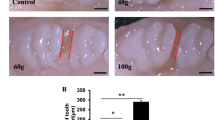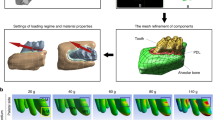Abstract
Purpose
The aim of this study was to evaluate the time course of orthodontic force-induced apoptosis and receptor activator of nuclear factor-κB ligand (RANKL)-induced osteoclastogenesis in a rat model under light- and heavy-force conditions.
Methods
Male Wistar rats were divided into light-force (10 cN) and heavy-force (60 cN) groups (N = 28/group). Each group was divided into four time-course subgroups to evaluate all phases of orthodontic tooth movement. Mesialization appliances were placed on three united maxillary molars unilaterally and activated. Tooth movements were calculated, and periodontal ligament (PDL) widths were measured. Expression of Bax, Bcl‑2, caspase 3, caspase 9, and RANK–RANKL were assessed by immunohistochemistry. Expression levels at the PDL–alveolar bone border were compared between experimental and control groups and force groups.
Results
The rate of tooth movement did not differ between the force groups. PDL widths were higher on the tension side in the heavy-force group in the post-lag phase. Pro-apoptotic protein Bax expression was elevated in the heavy-force group, whereas anti-apoptotic protein Bcl‑2 expression was elevated in the light-force group. RANK expression on days 7 and 21 and RANKL expression on day 21 differed between the force groups.
Conclusions
Evidence of orthodontic force-induced apoptosis is more robust with stronger forces than with weaker forces. Exuberant RANKL-induced osteoclastogenesis that was seen when applying a low force results from increased RANK and RANKL expression in the post-lag phase.
Zusammenfassung
Zielsetzung
Ziel dieser Studie war es, den zeitlichen Verlauf der durch kieferorthopädische Kräfte induzierten Apoptose und der RANKL(„receptor activator of nuclear factor κB ligand“)-induzierten Osteoklastogenese in einem Rattenmodell unter verschiedenen Kraftbedingungen zu untersuchen.
Methoden
Männliche Wistar-Ratten wurden je nach applizierter Kraft in 2 Gruppen unterteilt: geringere (10 cN) und höhere (60 cN; n = 28/Gruppe) Kräfte. Jede Gruppe wurde weiter in 4 Untergruppen unterteilt, um alle zeitlichen Phasen der kieferorthopädischen Zahnbewegung zu bewerten. Mesialisationsgeräte wurden auf 3 verblockten Oberkiefermolaren einseitig platziert und aktiviert. Zahnbewegungen wurden berechnet und die Breite des Parodontalligaments (PDL) gemessen. Die Expression von Bax, Bcl‑2, Caspase 3, Caspase 9 und RANK-RANKL wurde immunhistochemisch bestimmt. Die Expressionsniveaus an der PDL-Alveolarknochengrenze wurden zwischen Versuchs- und Kontroll- sowie zwischen den Kraftgruppen verglichen.
Ergebnisse
Die Geschwindigkeit der Zahnbewegung unterschied sich nicht zwischen den Kraftgruppen. Die PDL-Breiten waren auf der Spannungsseite in der 60-cN-Gruppe in der Post-lag-Phase höher. Die proapoptotische Protein-Bax-Expression war in der 60-cN-Gruppe erhöht, während die antiapoptotische Protein-Bcl-2-Expression in der 10-cN-Gruppe erhöht war. Die RANK-Expression an den Tagen 7 und 21 sowie die RANK-Expression an Tag 21 unterschieden sich zwischen den Kraftgruppen.
Schlussfolgerungen
Der Evidenznachweis einer kieferorthopädischen kraftinduzierten Apoptose ist bei stärkeren Kräften robuster als bei schwächeren. Die übermäßige RANKL-induzierte Osteoklastogenese, die bei Anwendung einer geringen Kraft zu beobachten war, resultiert aus einer erhöhten RANK- und RANKL-Expression in der Post-lag-Phase.







Similar content being viewed by others
References
Reitan K (1960) Tissue behavior during orthodontic tooth movement. Am J Orthod 46(12):881–900
Krishnan V, Davidovitch Z (2006) Cellular, molecular, and tissue-level reactions to orthodontic force. Am J Orthod Dentofacial Orthop 129(4):469.e1–469e32
Rana MW, Pothisiri V, Killiany DM, Xu XM (2001) Detection of apoptosis during orthodontic tooth movement in rats. Am J Orthod Dentofacial Orthop 119(5):516–521
Elmore S (2007) Apoptosis: a review of programmed cell death. Toxicol Pathol 35(4):495–516
Yang C‑Y, Jeon HH, Alshabab A, Lee YJ, Chung C‑H, Graves DT (2018) RANKL deletion in periodontal ligament and bone lining cells blocks orthodontic tooth movement. Int J Oral Sci 10(1):3
Van Leeuwen EJ, Maltha JC, Kuijpers-Jagtman AM (1999) Tooth movement with light continuous and discontinuous forces in beagle dogs. Eur J Oral Sci 107(6):468–474
Von Böhl M, Maltha J, Von den Hoff H, Kuijpers-Jagtman AM (2004) Changes in the periodontal ligament after experimental tooth movement using high and low continuous forces in beagle dogs. Angle Orthod 74(1):16–25
Owman-Moll P, Kurol J, Lundgren D (1996) Effects of a doubled orthodontic force magnitude on tooth movement and root resorptions. An inter-individual study in adolescents. Eur J Orthod 18(2):141–150
Ren Y, Maltha JC, Kuijpers-Jagtman AM (2004) The rat as a model for orthodontic tooth movement—a critical review and a proposed solution. Eur J Orthod 26(5):483–490
Ren Y, Maltha JC, Van ’t Hof MA, Kuijpers-Jagtman AM (2003) Age effect on orthodontic tooth movement in rats. J Dent Res 82(1):38–42
Verna C, Zaffe D, Siciliani G (1999) Histomorphometric study of bone reactions during orthodontic tooth movement in rats. Bone 24(4):371–379
Brooks PJ, Nilforoushan D, Manolson MF, Simmons CA, Gong S‑G (2009) Molecular markers of early orthodontic tooth movement. Angle Orthod 79(6):1108–1113
Korb K, Katsikogianni E, Zingler S, Daum E, Lux CJ, Hohenstein A et al (2016) Inhibition of AXUD1 attenuates compression-dependent apoptosis of cementoblasts. Clin Oral Invest 20(9):2333–2341
Kirschneck C, Proff P, Fanghaenel J, Behr M, Wahlmann U, Roemer P (2013) Differentiated analysis of orthodontic tooth movement in rats with an improved rat model and three-dimensional imaging. Ann Anat Anat Anz 195(6):539–553
Kaipatur N, Major P, Stevenson T, Pehowich D, Adeeb S, Doschak M (2015) Impact of selective alveolar decortication on bisphosphonate burdened alveolar bone during orthodontic tooth movement. Arch Oral Biol 60(11):1681–1689
AlSwafeeri H, ElKenany W, Mowafy M, Karam S (2018) Effect of local administration of simvastatin on postorthodontic relapse in a rabbit model. Am J Orthod Dentofacial Orthop 153(6):861–871
von Bohl M, Maltha JC, Von Den Hoff JW, Kuijpers-Jagtman AM (2004) Focal hyalinization during experimental tooth movement in beagle dogs. Am J Orthod Dentofacial Orthop 125(5):615–623
Kondo K (1969) A study of blood circulation in theperiodontal membrane by electrical impedance plethysmorgraphy. Kokubyo Gakkai Zassi 36:20–42
Kogure K, Noda K (2009) Periodontal response to experimental tooth movement by interrupted orthodontic force in rats. Orthod Waves 68(3):97–106
Li Y, Zheng W, Liu J‑S, Wang J, Yang P, Li M‑L et al (2011) Expression of osteoclastogenesis inducers in a tissue model of periodontal ligament under compression. J Dent Res 90(1):115–120
Kanzaki H, Chiba M, Arai K, Takahashi I, Haruyama N, Nishimura M et al (2006) Local RANKL gene transfer to the periodontal tissue accelerates orthodontic tooth movement. Gene Ther 13(8):678
Li X, Zhang XL, Shen G, Tang GH (2012) Effects of tensile forces on serum deprivation-induced osteoblast apoptosis: expression analysis of caspases, Bcl‑2, and Bax. Chin Med J 125(14):2568–2573
Moin S, Kalajzic Z, Utreja A, Nihara J, Wadhwa S, Uribe F et al (2014) Osteocyte death during orthodontic tooth movement in mice. Angle Orthod 84(6):1086–1092
Goga Y, Chiba M, Shimizu Y, Mitani H (2006) Compressive force induces osteoblast apoptosis via caspase‑8. J Dent Res 85(3):240–244
Matsuzawa H, Toriya N, Nakao Y, Konno-Nagasaka M, Arakawa T, Okayama M et al (2017) Cementocyte cell death occurs in rat cellular cementum during orthodontic tooth movement. Angle Orthod 87(3):416–422
Rodrigues LV, Del Puerto HL, Brant JM, Leite RC, Vasconcelos AC (2012) Caspase-3/caspase‑8, bax and bcl2 in pulps of human primary teeth with physiological root resorption. Int J Paediatr Dent 22(1):52–59
Igney FH, Krammer PH (2002) Death and anti-death: tumour resistance to apoptosis. Nat Rev Cancer 2(4):277–288
Ikeda F, Matsubara T, Tsurukai T, Hata K, Nishimura R, Yoneda T (2008) JNK/c-Jun signaling mediates an anti-apoptotic effect of RANKL in osteoclasts. J Bone Miner Res 23(6):907–914
Acknowledgements
No external funding, apart from the support of the authors’ institution, was available for this study.
Funding
This work was supported by Istanbul University Research Fund, project no. 32969.
Author information
Authors and Affiliations
Corresponding author
Ethics declarations
Conflict of interest
S. Kaya, M. Çifter, A. Çekici, V. Olgaç, H. İşsever and G. Işık declare that they have no competing interests.
Ethical standards
This study was approved by the Istanbul University Ethics Committee for Animal Research (2 January 2013, 2012/177). This study adhered to the Animal Research Reporting in Vivo Experiment guidelines. All applicable international, national, and/or institutional guidelines for the care and use of animals were followed.
Caption Electronic Supplementary Material
56_2019_205_MOESM1_ESM.pdf
Supplementary Table 1: Means, ranges (Min minimum and Max maximum) and standard deviations (Std dvt) for periodontal ligament (PDL) width. E experimental, C control
56_2019_205_MOESM2_ESM.pdf
Supplementary Table 2: Means, ranges (Min minimum and Max maximum) and standard deviations (Std dvt) for apoptosis pathway protein immunopositive cells count values on the pressure side. E experimental, C control
56_2019_205_MOESM3_ESM.pdf
Supplementary Table 3: Means, ranges (Min minimum and Max maximum) and standard deviations (Std dvt) for apoptosis pathway protein immunopositive cells count values on the tension side. E experimental, C control
56_2019_205_MOESM4_ESM.pdf
Supplementary Table 4: Means, ranges (Min minimum and Max maximum) and standard deviations (Std dvt) for RANK–RANKL immunopositive cells count values. E experimental, C control
Rights and permissions
About this article
Cite this article
Kaya, S., Çifter, M., Çekici, A. et al. Effects of orthodontic force magnitude on cell apoptosis and RANKL-induced osteoclastogenesis. J Orofac Orthop 81, 100–112 (2020). https://doi.org/10.1007/s00056-019-00205-6
Received:
Accepted:
Published:
Issue Date:
DOI: https://doi.org/10.1007/s00056-019-00205-6




